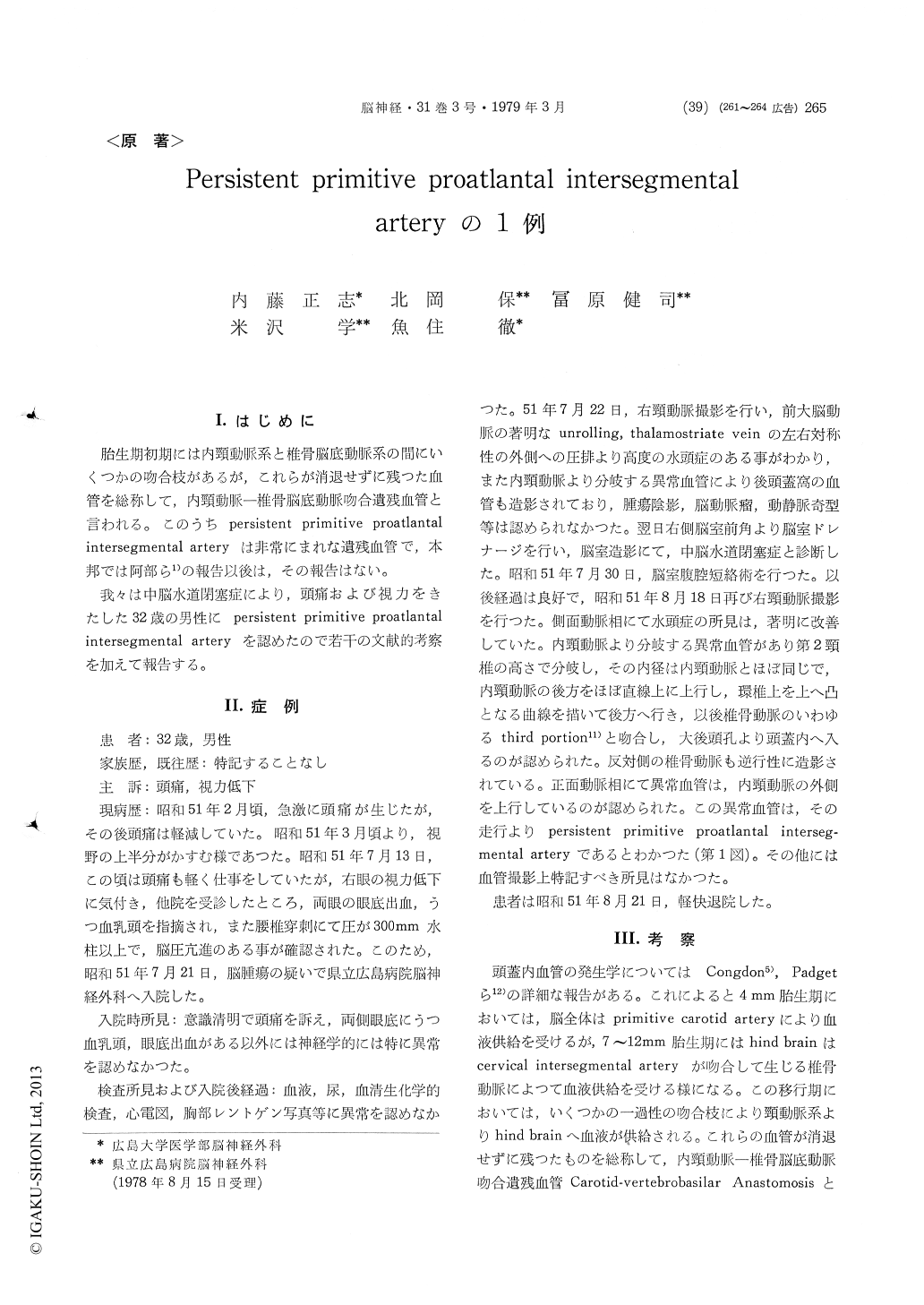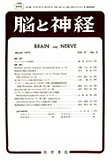Japanese
English
- 有料閲覧
- Abstract 文献概要
- 1ページ目 Look Inside
I.はじめに
胎生期初期には内頸動脈系と椎骨脳底動脈系の間にいくつかの吻合枝があるが,これらが消退せずに残つた血管を総称して,内頸動脈—椎骨脳底動脈吻合遺残血管と言われる。このうちpersistent primitive proatlantalintersegmental arteryは非常にまれな遺残血管で,本邦では阿部ら1)の報告以後は,その報告はない。
我々は中脳水道閉塞症により,頭痛および視力をきたした32歳の男性にpersistent primitive proatlantalintersegmental arteryを認めたので若干の文献的考察を加えて報告する。
A case of persistent primitive proatlantal interseg-mental artery with aqueductal stenosis is reported. This 32-year-old man was admitted to Hiroshima Prefectural Hospital for evaluation of headache and progressive deterrioration of visual acuity. Approxi-mately five months prior to admission, he developed sudden headache that resolved spontaneously but not completely. About four months ago, he noticed blurring of vision. And a week ago, he noticed aggravation of his right visual acuity.
Physical examination on admission on July 13th, 1976 revealed a well developed alert man complainig of a headache. The heart, lungs, carotid arteries, and remainder of the general physical examinations were normal. There were papilledema and retinal bleedings, but no other neurological abnormalities. Skull and chest films, CBC, blood chemical analyses, and urinalysis were all within normal limits. Right carotid angiography on the second hospital day demonstrated a marked hydrocephalus and an anom-alous carotid-vertebrobasilar anastomosis.
This anastomosis arose from the right internal carotid artery at the level of C2 and ascended vertically posterior to the internal carotid artery and turnd backward between the occipital bone and the atlas, forming a superiorly convex curve, and jointed with the third portion of the right vertebral artery. From this course the anastomosing vessel was known to be a presistent primitive proatlantal intersegmental artery. There were no other ab-normalities such as aneurysms, arteriovenous mal-formations, tumor stains and so on.
On the third hospital day, ventricular drainage yielded clear, colorless fluid under greatly increased pressure, and ventriculography revealed aqueductal stenosis. Following V-P shunt operation on thetenth hospital day, he got well and was discharged on the twenty-ninth hospital day. This is the ninth case of the persistent primitive proatlantal inter-segmental artery as far as we have collected. We discussed on the embryology, incidence, identifica-tion, and differenciation of this anastomosing vessel.
And we proposed criteria of the persistent primi-tive proatlantal intersegmental artery as follows.
1) This is a very rare anomalous carotid-vertebrobasilar anastomosis which arises from the external or internal carotid artery at the level of the second or third cervical vertebra.-more cephaladanastomosing vessels arise from the internal carotid artery whereas more caudal anastomosing vessel, cervical intersegmental artery arises from the ex-ternal carotid artery-
2) After arising from the external or internal carotid artery, this artery runs vertically and turned backward between the occipital bone and the atlas, forming a superiorly convex curve, and jointed with the third portion of the vertebral artery.
3) Afterwards it enters skull through foramen magnum as normal vertebral artery does.

Copyright © 1979, Igaku-Shoin Ltd. All rights reserved.


